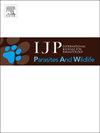加拿大艾伯塔省河獭脑内刚地弓形虫(ⅰ、ⅱ、ⅲ和12型)和肉囊虫的检测
IF 2.2
3区 医学
Q3 ECOLOGY
International Journal for Parasitology-Parasites and Wildlife
Pub Date : 2025-04-03
DOI:10.1016/j.ijppaw.2025.101069
引用次数: 0
摘要
刚地弓形虫和肉囊虫是全球分布的球虫寄生虫,感染吸热脊椎动物。刚地弓形虫是人畜共患疾病,在全球人类、家畜和野生动物中广泛流行。肉囊虫是一个相关的和多样化的属,其物种使用一系列的确定和中间宿主。在中间宿主中,这些组织栖居球虫可无症状或通过神经、肝脏和经胎盘感染引起疾病。由于陆地径流进入淡水环境,北美水獭(Lontra canadensis)等半水生哺乳动物暴露于弓形虫和肉囊虫的风险很高。它们的高营养地位和双重栖息地利用使它们成为监测生态系统中食物和水传播病原体存在的优秀哨兵物种。研究人员从加拿大阿尔伯塔省89只水獭的脑组织中取样。采用磁捕获序列特异性DNA提取和qPCR技术,在34%的水獭中检出弓形虫DNA。采用巢式PCR及GRA6和SAG2基因测序方法鉴定了弓形虫的基因型,包括在北美最常见的克隆谱系I、II和III型,以及在海獭中具有高致病性的12型(X/A)。采用常规PCR方法,以ITS1和18S核糖体区域为引物,在30%的水獭脑裂解物中检测到Sarcocystis sp .的DNA,测序结果显示,S. lutrae是与S. kitikmeotensis最接近但不同的一种。本研究表明,水獭营养暴露于由猫科动物传播的弓形虫和由未知最终宿主传播的至少2种肉囊虫。在该种群中未检测到高致病性神经棘球菌,可能反映了加拿大北部负鼠最终宿主的缺失。弓形虫和肉囊虫对河獭行为、健康和繁殖的潜在影响值得进一步调查。本文章由计算机程序翻译,如有差异,请以英文原文为准。

Detection of Toxoplasma gondii (Types I, II, III and 12) and Sarcocystis spp. in the brains of river otter (Lontra canadensis) from Alberta, Canada
Toxoplasma gondii and Sarcocystis spp. are globally distributed coccidian parasites infecting endothermic vertebrates. Toxoplasma gondii is zoonotic, with widespread global prevalence in humans, domestic animals, and wildlife. Sarcocystis is a related and diverse genus, with species that use a range of definitive and intermediate hosts. In intermediate hosts, these tissue dwelling coccidians can be asymptomatic or cause disease through neural, hepatic, and transplacental infections. Semiaquatic mammals such as the North American river otter (Lontra canadensis) are at high risk of exposure to T. gondii and Sarcocystis spp. due to terrestrial runoff into freshwater environments. Their high trophic position and dual habitat use make them excellent sentinel species to monitor the presence of food and waterborne pathogens in ecosystems. Brain tissue was sampled from 89 river otters in Alberta, Canada. DNA of T. gondii was detected in 34 % of otters using magnetic capture sequence-specific DNA extraction and qPCR. Genotypes of T. gondii were identified using nested PCR and sequencing of the GRA6 and SAG2 genes, and included the most common clonal lineages in North America, Types I, II, and III, as well as Type-12 (X/A), which is highly pathogenic in sea otters. DNA of Sarcocystis spp. was detected in brain lysates of 30 % of otters via conventional PCR with primers targeting ITS1 and 18S ribosomal regions, and sequencing revealed S. lutrae and a species most closely related to, but distinct from, S. kitikmeotensis. This study suggests that river otters are exposed trophically to T. gondii shed by felids, and at least 2 species of Sarcocystis shed by unknown definitive hosts. Highly pathogenic S. neurona was not detected in this population, likely reflecting the absence of possum definitive hosts in northern Canada. The potential effects of T. gondii and Sarcocystis spp. on behaviour, health, and reproduction of river otters warrant further investigation.
求助全文
通过发布文献求助,成功后即可免费获取论文全文。
去求助
来源期刊

International Journal for Parasitology-Parasites and Wildlife
Medicine-Infectious Diseases
CiteScore
3.80
自引率
5.60%
发文量
113
审稿时长
45 days
期刊介绍:
The International Journal for Parasitology: Parasites and Wildlife (IJP-PAW) publishes the results of original research on parasites of all wildlife, invertebrate and vertebrate. This includes free-ranging, wild populations, as well as captive wildlife, semi-domesticated species (e.g. reindeer) and farmed populations of recently domesticated or wild-captured species (e.g. cultured fishes). Articles on all aspects of wildlife parasitology are welcomed including taxonomy, biodiversity and distribution, ecology and epidemiology, population biology and host-parasite relationships. The impact of parasites on the health and conservation of wildlife is seen as an important area covered by the journal especially the potential role of environmental factors, for example climate. Also important to the journal is ''one health'' and the nature of interactions between wildlife, people and domestic animals, including disease emergence and zoonoses.
 求助内容:
求助内容: 应助结果提醒方式:
应助结果提醒方式:


